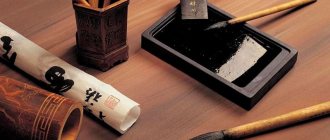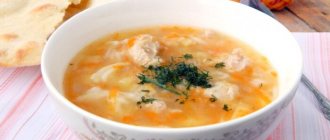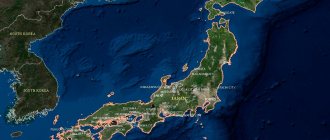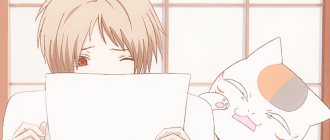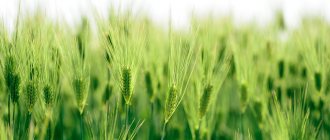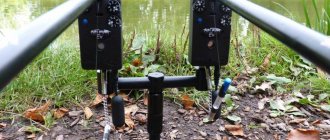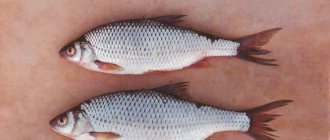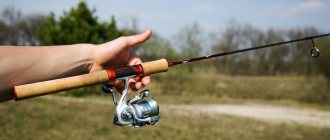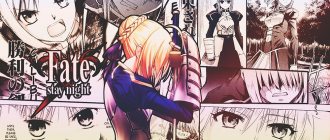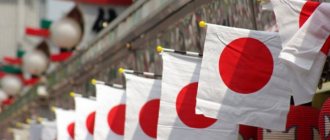The history of kun and on reading
In Japanese, characters are called kanji (漢字). Literally, the word kanji is translated as “Han characters,” that is, the signs of the Han Dynasty. The hieroglyphs themselves originated in China from pictograms, in other words, schematic drawings, which later developed into a more complex ideographic system. The age of Chinese writing is constantly being clarified. Scientists attribute the appearance of pictograms to the 4th century BC. BC, which means that the Chinese hieroglyphic system may be even older than the Sumerian cuneiform script.
Until 4-5 centuries AD The Japanese did not have their own writing. The Japanese transmitted songs, stories and legends orally, without recording them on paper. In the 4th century, Buddhist teachings came to Japan from the Korean state of Baekje. Buddhism contributed to the strengthening of centralized political power, and therefore was of great interest to the imperial house. Prince Shotoku Taishi gave the Buddhist religion state status. In this regard, many texts and sutras appeared in Japan in Chinese and Sanskrit, which contributed to the spread of written language and, first of all, Chinese characters. At first, the Japanese read Chinese texts in Chinese, adhering to all the rules and grammar, then the tests gradually began to be translated into Japanese. Until the Nara era (710-794), the Chinese language and writing were official in Japan; state documents and even personal letters were written in Chinese using Chinese characters.
Subsequently, the Japanese began to use hieroglyphs to record their native Japanese speech. This led to a complex system of reading characters that exists in the Japanese language to this day. Let's try to figure it out, it will help us understand kun and on reading!
Onnoe and kunnoe reading in simple words
In the Japanese language there are 2 types of readings: onnoe, or on'yomi (音読み), which is also called Chinese reading, and some Russian Japanese scholars call it "upper", and kunnoe, or kun'yomi (訓読み), which in Russian can be called Japanese reading or " bottom." As you might guess, on-readings are those readings that were originally in the Chinese language, but were adapted to Japanese phonetics. Kun readings are translations of hieroglyphs into the original Japanese language. The character 訓 itself, used in the word "kun'yomi", means "translation, commentary." Thus, according to onny readings, words of Chinese origin, or kango (漢語), will be read, and according to kun readings, words of Japanese origin, or wago (和語), will be read and written.
Usually onny readings in dictionaries are written in katakana, and kun readings in hiragana. In most Russian-language textbooks, Chinese readings and Japanese are distinguished by a horizontal line, hence the colloquial division of readings into “upper” and “lower” arose.
When you study a hieroglyph, you need to remember the following characteristics:
1) Writing, order and direction of strokes
2) On-readings
3) Kun readings
4) Value range
5) Key
6) You should also pay attention to the combinations in which this or that hieroglyph is used
Why are we talking about readings, and not just reading?
There can be from 1 to 3 Chinese, or on, readings for one hieroglyph. This number is associated with repeated borrowings of hieroglyphs in later centuries and from other dialects of the Chinese language. For example, the character 人 has two Chinese readings: jin (ジン) and nin (ニン). When talking about nationality, the Chinese reading jin (ジン) will be used, for example, in the word “Japanese”: 日本人 (nihonjin). When talking about the number of people, this character will be read as nin (ニン), for example, “five people” 五人 will be read as gonin. It is for this reason that when studying hieroglyphs it is worth paying attention to combinations, and if a hieroglyph has several on-word readings, then it is necessary to remember in which case which of these readings is used, it is important to know about the kun and on-word readings.
As for Japanese or kun readings, firstly, they may not exist at all. Like the character 福, which means happiness, there is only one Chinese reading, fuku (フク), and there are no other readings. Of course, such hieroglyphs are convenient because we do not have to choose from several reading options. On the other hand, some characters number up to a dozen or more kun'yomi. The most striking example of such a character, frankly speaking, inconvenient for memorizing, is 生 - “to live, to be alive”, the readings of which are sei (セイ) and shou (ショウ).
Let's look at his kun readings:
1) u-mareru (う・まれる) – to be born
2) u-mu (う・む) – to give birth
3) i-kiru (い・きる) – live, be alive
4) i-kasu (い・かす) – to keep alive, to use optimally
5) i-keru (い・ける) – do ikebana
6) na-ru (な・る) – bear fruit, bear fruit
7) na-su (な・す) – to give birth, to form
ha-eru (は・える) – to grow, to grow (about plants, hair)
9) ha-yasu (は・やす) – grow, let go (beard, wasps)
10) mu-su (む・す) – to grow, become overgrown (with moss)
11) nama (なま) – raw, unprocessed
12) ki (き) – unrefined
The bad news: there are not even 10, but 12 readings. The good news is that there are not many characters with such a huge number of kun readings in the Japanese language. The standard is, as in the case of on-line readings, about 2-3 readings.
The next point worth paying attention to is okurigana (送り仮名).
You may have noticed that, for example, in the reading u-mareru (う・まれる), “to be born,” in the hiragana notation there is a dot inside the word, and in the Latin notation there is a dash. In this case, this dash (dot) means that the tail -mareru (まれる) will be written after the character. It looks like this: 生まれる (u-mareru). That is, the character itself only covers the reading u- (う), which is the root of this verb. Next comes the inflected verb ending. Since it changes, we cannot “keep” it inside the hieroglyph, therefore, in all verbs and adjectives, endings that will change depending on indicators of tense and politeness, these endings will go beyond the hieroglyph. Such endings, which are written after the hieroglyph, but are still part of the reading, are called okurigana. In fact, okurigana is a very convenient guide: if you see that after a character comes hiragana, then this character will be read according to its Japanese reading.
100+ first kanji in a mnemonic way. Part one
Hello, a mini-project has been launched especially for social groups with 100 kanji written for visual and mnemonic memorization at an accelerated pace. However, the format of the social network still does not make it possible to describe the cards in more detail, provide more detailed information, as well as some practical recommendations. However, if the cards are immediately intuitive, then you can visit the VK album, all the cards of the cycle of the first 100 kanji will be collected there.
It is also worth noting that almost every character (with the exception of a few characters) will be added in a certain sequence according to its component parts, or the addition of visual images. The sequence will be accompanied by comments in the post.
So, before considering the selection of cards, you need to take into account the following practical tips (they help most people, but you can always “upgrade” the system to suit your needs - no one has a rolling pin over their soul *))). These are the recommendations:
- Look at the card, remember the visual image (if it doesn’t suit you, find or come up with your own, which is more convenient for you). At this stage, the visual type of memory is connected, even if it is not your profiling one, it is better to start with it. A partially discrete type of memory is also activated, the brain looks for associations and makes logical connections.
- Write the kanji 5-15 times, noticing details, noting some features, if this symbol reminds you of another, because Looking ahead, there will be cards with a method for comparing similar kanji. (alas, it’s difficult to do without the kinesthetic method. Yes, not all people have a kinesthetic type of memory, however, as practice shows, “seeing something is stored in the head, hearing something, we realize it, having done it, we understand it.” The kanji script fits the definition of “having done "). As you understand, the kinesthetic type of memory is involved - the type of memory through physical actions.
- When writing kanji, try to dictate to yourself the kun and on types of reading the symbol - this way you can remember the types of reading. After all, students usually read kanji in texts out loud at the very beginning, and even if you read to yourself, it’s still as if you “hear” your voice or intonation. This is especially true for people with a profiling auditory memory type. In this way, you will already remember not only the meanings of kanji, but also how it can be read. * At the very beginning, you will most likely make mistakes in words, but if you remember the sounds of on-kun readings, then gradually this situation will improve.
Thus, to the mnemonic-associative memorization of kanji, the involvement of all three types of memory was added (one might even say four, since the brain builds logical associations). Regardless of what type of memory you have, it is always the case, as the practice of me and many other students of level N3 and above who are strong in kanji shows, that the technique works.
The following exercises will also help with this technique:
* Having set a goal to study 25-30 characters per week or about 1000 characters per year (why waste time), you can record the following sound file : Meaning (or meanings) of kanji in Russian, types of readings (kun, he through pauses. So, if you have several Kun and several On readings, then the pause between Kun readings should be shorter, and before reading On types of readings, you should take a longer pause). Listening to the data of 25-30 files (according to the number of characters that you are learning) on the player, try to reproduce the appearance of kanji or at least the association and picture.
* Do a “big clean” once a week. Take a dictionary and look for simple types of word reading without looking at the transcription. Or, if your kanji dictionary or vocabulary is generally small, write just the kanji symbol on one side of the card and the meaning on the other. Look through the symbols and try to remember what they mean and their reading types. Then look up the meanings, try to write by hand, or type on the computer what the symbol might look like and remember all the reading types that come to mind. Trainers for mobile devices also help with memorizing kanji. Unobtrusively, while waiting for the train, waiting in line, or a long wait in the subway, you can go through the kanji levels and try to remember the past.
After these exercises, divide the kanji into 2 parts: 1) kanji that you remember well, or remember not very well, but either have learned the reading types well, or the meanings 2) kanji that you do not remember at all. These two lists need to be worked separately. The second list smoothly moves on to the next week, you repeat the previous actions, BUT give out another association, perhaps the association you chose is not strong enough and not “speaking” enough. The first list is postponed until “somehow”. And when a month or two has passed, see how many kanji you still remember.
Now about the cards presented in this post: Everyone can notice that the kanji are collected from all different levels . The fact is that many symbols follow the Noryoku Shiken JLPT gradation, and the material is built, as noted above, from simpler to complex, and then a simple element is added again, and the sequence is added again. Then the process is repeated. That is why in each collection kanji of different levels will be given, in any case, whatever your current level, the kanji are quite simple (the order of writing the strokes is also given) + if you intend to reach the end (to the first level), then simple kanji “ to grow” will never hinder you.
So let's get started. One of the simplest kanji is “Asia”. And although it is included in the second level, you can remember it once and for all now:
For the next kanji, alas, you cannot do without knowing the element “heart”. Author's omission. And yet, this part is especially simple, and the heart symbol can be remembered right on this line 心. Asia is pressing on the heart, separation is obviously not something good. Meaning: “bad”, “evil”.
And this picture is probably familiar to many. What is “captured” here, albeit briefly, is how people saw the mountains and how it was transformed into kanji.
Now another association is a big boulder and a big hill. Sounds like a rock, doesn't it?
What if you add the previous two kanji characters? Those. a boulder-stone and a mountain, then you get a rocky mountain or a rocky mountain. In general, many kanji can be composed of simple components:
Go ahead. A simple component “Woman”. In many books it is presented as a pregnant and formless something. But I have an association with this pose from Wushu (Tai Chi), which is called “the snake slides from the branch.” The Chinese woman performing this element (after all, kanji came from China), the very visuality of the element, and, of course, the biblical “serpent”, “Eve”, “first woman”. Such is the association. More graceful, don't you think?
If 3 kanji for “woman” are placed side by side, then many of us may have the association that 3 friends meet and noisy chatter begins over a glass of cocktail; some may remember three “sultry aunts” who made noise on market day. But there will also be those who will think of something seductive when there is a choice of three beauties. In any case, you can’t go wrong – “noise, commotion, temptation” – this is all about the Kanji, consisting of three women.
Another kanji. By the way, quite common. After all, society often tells us “need” / “don’t need”. And here’s the association: if a woman (you’ve already memorized her kanji) is dragging a heavy machine on her head, it means she NEEDS it.
Another simple element that is included in a good half of the hundred most common kanji: the sun element. It is easier, as it seems to the author of the post, to remember it by origin. On the left is how the sun symbol was seen by the ancients, and on the right (the last sequence of arrows) is how kanji looks now.
And one more Kanji character, which is better and easier to remember by origin. Where the sun is, there is the moon
If we add the two previous symbols (sun + moon) together, then we understand that these are bright outlines before dawn, everything begins to be clearer, i.e. more obvious, something seems to be revealed to our gaze.
The next card can speak for itself. If you have the word “STOP” in front of your eyes, then you can briefly study the following picture:
And one more element that can be remembered associatively by origin: “river or stream.”
And this element is already more associated with personal associations - a lot of words through a “mouthpiece”. Meaning of “speech”
If you add the previous 2 symbols: “speech” and “streams”, it turns out that someone is explaining something to you. Lots and lots of it. And in every detail. And if they explain a lot to you, then this can be good training.
One of the first kanji that is given as follows in many textbooks. The sun rises behind the trees in the east. This is exactly how people originally painted him. However, if you remember that the sun is 日, then you can “complete the rest visually.”
And this kanji is literally a “quote” from Len Walsh’s textbook “let’s read Japanese today.” Previously, in capitals and small towns there were such lanterns; it was, as it were, a symbol of the city. And the kanji itself, which was depicted as a lantern or a house for the gods,” did not change very much. It still resembles the good old “house”.
And the last sequence for mnemonic memorization of kanji. Previously, and even now, rice fields were cut into slits, which were filled with water, and along which people walked. These slots even now resemble smooth and measured squares. As a result, kanji is easily remembered by all those who have seen rice fields at least once in a picture.
Have you ever mowed with a scythe? Those who have at least seen this understand that forces (even though this is a simple type of lever) still have to be applied immeasurably. The key word is “POWER”, and the braid is like an association.
Let's return to the topic of hard work in the field. Only a strong man can plow the entire field. Therefore, if you add up “field” and “force” (by this point you can already remember the constituent parts of the kanji), you will get a real “man”.
And finally, the last association of the post: if you also give a real man a cocked hat, then he will generally be a very gallant and courageous man, for example Admiral Nelson, the one who was used for this card. And the kanji means “bravery, bravado.”
All the post cards took about 7 hours of work, so I would be grateful for sharing the work on social networks. Also, you can completely copy the contents of this post, BUT indicating the original source, i.e. of this blog
*For the post, personal associations were used, both obtained from certain books, such as Len Walsh, and completely personal visual images and personal vision of kanji.
If you find an error, please select a piece of text and press Ctrl+Enter.
Share on social media networks
RќСЂР°РІРёС‚СЃСЏ
What about onon or kun? Basic reading rules.
So is it according to him or according to kun?
One way or another, for people studying Japanese, the question remains a great intrigue and mystery: how can I still read the hieroglyphs that I see in the text - by onon or by kun?
Let's look at the basic rules about kun and on reading.
1) Hieroglyphic combinations consisting of 2 or more hieroglyphs are usually read according to onny, Chinese readings:
先生 (sensei) - teacher
日本人 (nihonjin) - Japanese
自動車 (jidousha) - car
2) A separate hieroglyph (that is, there will be hiragana or other words to the right and left of it) is read according to kun, Japanese readings:
生ける (ikeru) - to do ikebana
あの人 (anohito) - he, she
車 (kuruma) - car
Separately, a stylistic difference should be noted: the words of Chineseisms (in fact, words read according to onic readings) sound more formal, scientific, official, dry. They are widely and often used in scientific literature, official documents, contracts, public speeches by politicians, and news. Words of Japanese origin are more typical of ordinary everyday speech and sound simpler and more down-to-earth. Thus, the words 車 (kuruma), a car, will be used more in a domestic context, and the word 自動車 (jidousha), a car, will be used when talking about a car plant or production volumes.
Unfortunately, the above rule only works in 80-90% of cases, and in Japanese the opposite situation can be observed:
3) There are free-standing characters that will be read, no matter what, in Chinese, even if they have Japanese readings:
本 (hon) - book
絵 (e) - picture
円 (en) - yen
About combinations:
4) There are hieroglyphic combinations that will be read according to Kun, Japanese, reading:
父親 (chichioya) - father
白黒 (shirokuro) - black and white
旅人 (tabibito) - traveler*
*In this word we also observe voicing of the initial consonant of the second root (hito → bito), which is characteristic of Japanese root formation, but, unfortunately, there is no single rule for this phenomenon; in some cases voicing occurs, but in others it does not. You can remember this only together with learning vocabulary.
5) There are hieroglyphic combinations in which part of the hieroglyphs will be read according to on, and the other part according to kun:
半年 (hantoshi) – six months
目茶 (mecha) - absurdity, absurdity
日曜日 (nichiyoubi) - Sunday
At the same time, sometimes the onn reading is in first place, and the kun reading is in second, while in other combinations we see the opposite situation. Particularly noteworthy is the last word 日曜日 (nichiyoubi), "Sunday", since in it the character 日, meaning "sun, day", is repeated twice, the first time being read as "nichi", and the second as "bi" . Where is the logic? - you ask. And you’ll be right, because it simply doesn’t exist. It is for this reason that when studying hieroglyphs, it is necessary to pay attention not only to the list of on and kun readings, but also to the combinations in which this hieroglyph is used.
6) In addition to the above, there is a special category of readings of hieroglyphic combinations, which is called ateji (当て字). Ateji arose due to the fact that some native Japanese words began to be written not with one, but with two hieroglyphs, for example:
今日 (kyou) - today
大人 (otona) - adult
一人 (hitori) – 1 person
Usually in textbooks on hieroglyphs such combinations, read in a non-standard way, are also written out and marked separately as exception words.
7) And finally, there is a special category of hieroglyphs called kokuji (国字), literally translated as “signs of the native country.” These are the hieroglyphs that were invented by the Japanese themselves, so such hieroglyphs do not have Chinese readings. They will be read only according to kun:
畑 (hatake) - vegetable garden
峠 (tooge) - mountain pass
込む (komu) - to be crowded
Japanese Simple
10 kanji, 24 words to consolidate.
1. The first kanji in the textbook, and probably the most important for the Japanese, is the kanji 日, which means “sun”. Also write down the meaning of "day". Many reading options immediately arise, I suggest remembering kunyomi ひ, and onyomi ニチ. Yes, I haven’t said this yet, but it is customary, to make it easier to distinguish, to write kun’yomi (Japanese readings) in hiragana, and on’yomi (Chinese readings) to write in katakana. You may ask, why don’t other readings need to be memorized? But because this kanji occurs so often in words, and it has so many variants of exceptional readings, that you won’t remember everything. Write down the main ones, and whenever you see a word with the kanji 日, understand that the reading may be an exception. As reference words, you can take 日 (ひ) sun/day, and 日本 (にほん) Japan.
2. The following kanji again has two main meanings: "moon" and "month". This is the kanji for 月. It also occurs quite often in words. Kunyomi つき, onyomi ゲツ and ガツ. Three reference words: 月 (つき) moon, 月曜日 (げつようび) Monday, 1月 (いちがつ) January.
3. Next comes the kanji for "tree" 木, with its readings き, モク and ボク. The kanji tree is no longer as common in ordinary words as the first two. But it is quite often found in words related to trees and wood, as well as in surnames. Key words: 木 (き) tree, 木曜日 (もくようび) Thursday.
4. 山 kanji for “mountain”, found in words even less frequently than the previous ones, but still common in surnames. Kunyomi やま, onyomi サン. Key words: 山 (やま) mountain, 火山 (かざん) volcano. Sometimes, while studying kanji, you can come across funny combinations of kanji according to their meaning when forming new words. Probably, when words were just being invented, everyone tried to write down the word, choosing the kanji that had the correct meaning. However, the knowledge of the ancestors was often not enough to correctly describe the true meaning of the word, so it cannot be said that now all words consist of kanji in meaning. You can often come across something stupid or simply an incomprehensible set. Let's take the word 火山 volcano - it consists of the kanji for "fire" and "mountain". Everything is good in this word; the volcano seems to us, like the ancient Japanese, as a fiery mountain. I would also like to note that in this word the reading of mountain サン is voiced to ザン, this is also a common occurrence when kanji appears at the end or middle of a word. Always be careful, even if you know all the kanji readings, you can make a mistake.
5. "River" 川, another kanji that appears often in surnames, but not so often in words. From readings, you can only remember kunyomi かわ, there are very few words in which this sign is read by onyomi. Take the usual river 川 (かわ) as a reference word.
6. Kanji for “field”, meaning a rice field, that is, a flooded field. If you are interested in agriculture, you will probably see this kanji a couple of times in the names of various fields. An ordinary person, most likely, will not see this kanji anywhere except for the surnames 山田 (やまだ) and 田中 (たなか). Therefore, write down two readings for this kanji: た and だ (both variants of kun'yomi). And remember two common Japanese surnames: Yamada and Tanaka.
7. Man in the broad sense of the word. This kanji appears super often in words. These can be words from completely different areas and topics. Exceptional readings are also present. However, let's remember the readings ひと, ニン and ジン. And also supporting words: 人 (ひと) person, 3人 (さんにん) three people, 日本人 (にほんじん) Japanese.
8. Kanji for “mouth” 口. In addition to its main meaning, it also has connotations of “entrance” and “hole”. Due to this, it is found in words that have nothing in common with the human mouth. Kunyomi くち, onyomi コウ. There are 4 key words at once: 口 (くち) mouth, 入口 (いりぐち) entrance, 出口 (でぐち) exit, 人口 (じんこう) population.
9. Next comes the kanji for “car”. Machine in the sense of a car. The kanji itself looks like a cart. It is part of several good words that are often found. Sometimes “wheel” has the meaning. Kunyomi くるま, onyomi シャ. Remember three key words: 車 (くるま) car, 自動車 (じどうしゃ) car, 電車 (でんしゃ) train.
10. The last kanji in this lesson, the kanji for "gate". If you open this kanji card in Yarksi, you will see a lot of things. But in fact, apart from the words “gate” 門 (もん) and specialty 専門 (せんもん), I have never seen it anywhere.
At the end of the lesson I will make a summary table of kanji, their meanings, readings, and key words. Once again, these are just the main points that you need to remember at first. For everything else, there are full word cards in Yarksi. Sometimes some reading may be missing there too, then you need to Google it in Japanese online dictionaries.
The BKB tutorial shows the stroke order of each kanji, try to draw it that way. The number of these very features is also signed. Don't change these rules to your taste, otherwise your kanji will become different, not what they should be, and they will be difficult to parse.
No matter how large the number of features of the sign is, they all must fit into a standard square!
lesson-1-plate
A proven way not to get confused when reading a hieroglyph
The last important topic to cover is vocabulary. It is necessary to inextricably study vocabulary and hieroglyphs.
The above rules may seem very complex and inconsistent to you. And indeed, if you study hieroglyphs alone, it will be quite difficult, when faced with a hieroglyph in the text, to guess with 100% probability how it will be read. On the other hand, studying and knowing Japanese vocabulary can be a very good help in this. For example, first from the general Japanese language course you will learn that there is a word for “adult”, otona. Later, when studying the hieroglyphs “big” and “man”, you will come across the fact that otona is written as “big man” (大人), and this spelling will become something natural and self-evident for you.
Kun and onn reading may seem like a complex system, but the general rule remains that in the vast majority of cases a single hieroglyph will be read according to kun reading, and hieroglyphic combinations of 2 or more hieroglyphs will be read according to on.
